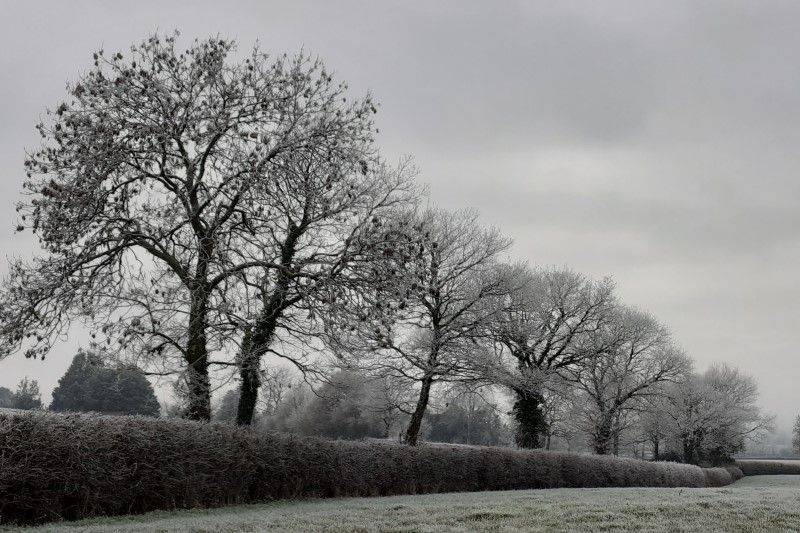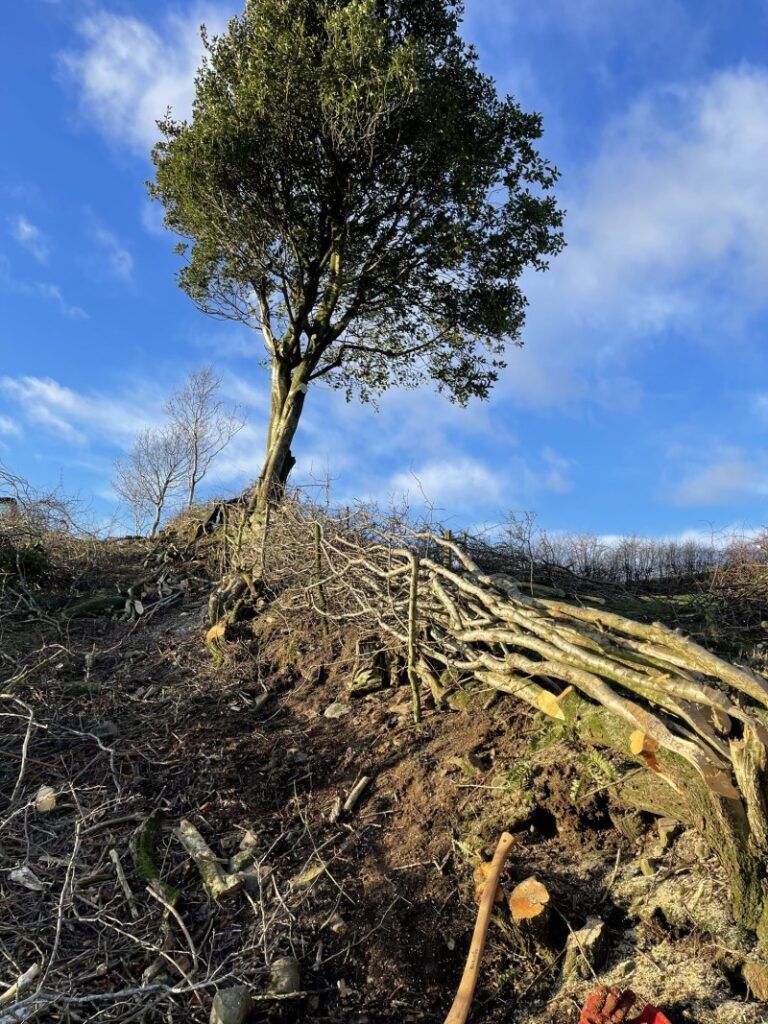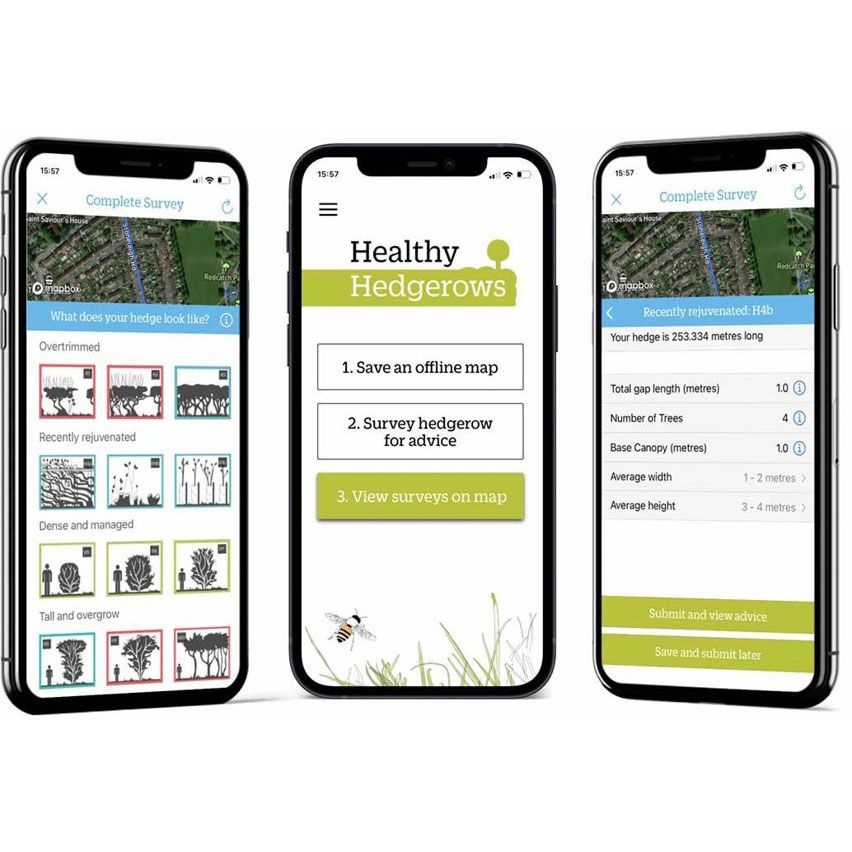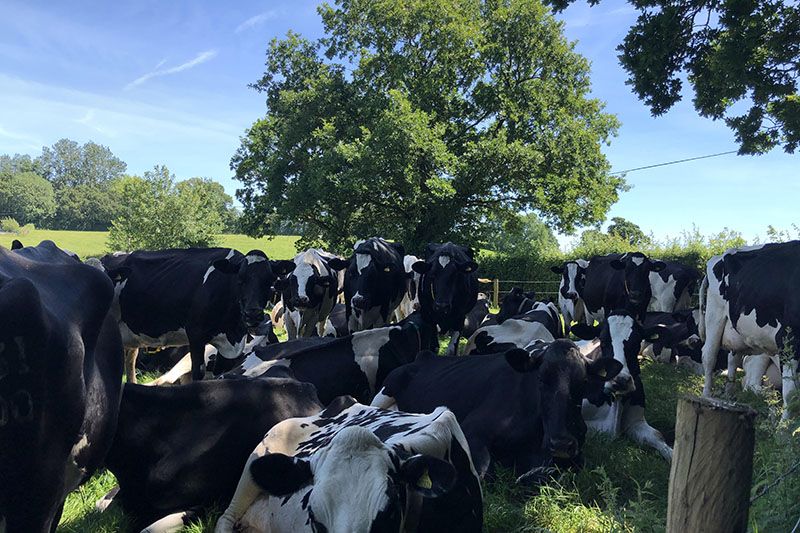Hedgerow trees

The number of hedgerow trees has been in sharp decline over the decades but with a few simple steps, you can establish and maintain healthy trees for a long time to come
Hedgerow tree loss
The number of hedgerow trees in our hedges has been in sharp decline over the decades. We lost considerable numbers to Dutch elm disease. Now we’re on the brink of losing a huge number to ash dieback (and sadly, ash is one of the most common hedgerow trees) and, in general, older hedge trees are dying at an increasing rate.
Add to this, the way we have been managing our hedge trees has not led to enough new hedge trees being established, and it’s clear that there is an emerging problem. Current rates of young tree recruitment are less half the number we need to just maintain the current tree population.

The striking comparison of old maps with current satellite images, shows just how many hedgerow trees we used to have compared with now. The dots on the map on the left, an old Ordinance Survey map of the 19th century, are all mature hedge trees; a startling difference when compared with what those same hedges look like now.
This website allows you to see the same comparison across the country.
A few benefits of hedgerow trees
Why’s it important to maintain trees in our hedgerows? Of course, having more trees in a hedge may make it slower to trim, but there are a huge number of advantages to having a healthy population of hedgerow trees:
- Shade for livestock, which will be increasingly important with the long hot summers we are experiencing with climate change
- Shelter for livestock welfare, especially with increasingly wet and stormy winter/spring conditions
- Hedgerow trees flower and fruit, important in years where the hedge below them is cut and won’t provide so much food for wildlife
- Improving habitat – over half the priority species using hedgerows require hedge trees; for food, shelter and nesting. They also support important animal behaviours – birds sing from them and use them as territory markers, butterflies gather and mate, bats prefer hedges with trees to echolocate along
- Increase carbon storage in a hedge, and can offer a more stable, long term store; whilst the hedgerows below them will need to go through periodic rejuvenation, hedge trees can persist for generation after generation
- Establishing trees in hedgerows doesn’t take land out of production
- Flexible uses for wood fuel, coppicing, pollarding or grown for harvestable fruit and nuts
Ways to establish new hedgerow trees
Increased loss and decreased gain of hedge trees has a dramatic effect on the numbers. We can’t do much about this tree loss, but we can put more emphasis on growing more hedge trees.
1. Find a suitable young stem in the hedge, and spare it from the hedge trimming. You may wish to tag or mark it somehow to make sure it isn’t accidently trimmed
2. Leave some good stems standing when you next lay or coppice the hedge
3. Plant a tree in a hedge gap, or in a notch cut into the hedge. (There is government funding that can cover the cost of hedge tree planting)

The benefits of options 1 and 2 are that they are free, they don’t require digging holes, using plastic spiral guards or watering, and most importantly, (especially for older hedges) they retain the genetic diversity of your local tree populations.
The advantages of option 3, planting a hedge tree, is that you can chose what tree goes where and use it as a way of increasing the number of species in your hedge. This is especially useful for hedges that may only have one or two tree species in, such as enclosure style hawthorn hedges.
There are several advantages to a diversity of different types of hedge tree. It adds flexibility as different trees suit different locations, it adds some protection in the face of any new emerging tree disease, and it creates a more diverse set of habitats which is better able to feed and nest our diverse wildlife. One great example of this latter point comes from hairstreak butterflies. Brown hairstreak butterflies rely on young blackthorn leaves which feed the caterpillars, but they also need hedgerow trees, particularly big ash trees to act as a gathering point to mate. Purple hairstreak butterflies on the other hand gather at oak trees, and white letter hairstreak at elm. A diversity of trees caters best to the diverse requirements of wildlife.
Planting new hedge trees in gaps in a hedgerow is best done when rejuvenating the hedge through coppicing or laying. This prevents the existing hedgerow from shading the newly-planted trees. Local tree genetic diversity can still be retained by acquiring young tree stock from community tree nurseries.
Establishing trees in a hedge network is clearly a good thing. However, this shouldn’t be confused with allowing the scrub/shrub layer of the hedgerow to develop into a line of trees. This isn’t good for wildlife as all of the dense vegetation providing valuable shelter is lost at the base of the hedge.
Over time a line of trees will be lost as individual trees complete their life-cycles. This reduces the carbon storage capacity. A better option for both wildlife and carbon storage, is to manage the scrub layer according to its natural life-cycle, while managing and establishing isolated hedgerow trees.
Hedgerow tree diversity
There are several advantages of having a diversity of different types of hedge tree; it adds flexibility as different trees suit different locations, it adds some protection in the face of any new emerging tree disease, and it creates a more diverse set of habitats which is better able to feed and nest our diverse wildlife.
One great example of this latter point comes from hairstreak butterflies. Brown hairstreak butterflies rely on young blackthorn leaves which feeds the caterpillars, but they also need hedgerow trees, particularly big ash trees to act as a gathering point to mate. Purple hairstreak butterflies on the other hand gather at oak trees, and white letter hairstreak at elm.
Only with a diversity of trees can we cater to the diversity of requirements of our native wildlife.
Hedge tree top tips
- If establishing a hedge tree that is likely to cast deep shade, such as oak, consider planting shade tolerant hedge species either side, like hazel or holly.
- Hedge plants such as hawthorn and blackthorn are not very happy in heavy shade, they may get leggy stretching for the light and might be lost altogether when sat under an oak canopy. So in hawthorn dominant hedges, think about planting trees that don’t throw such deep shade, or smaller trees such as crab apple, rowan, hazel.
- Whilst the shade of a tree is where you’ll find your animals on a sunny day, shade on arable fields can be problematic. If/where this is a concern, plant your small hedge tree species in your East-West hedges to minimise any shading problem. Save your big hedge trees like oak and beech in your North-South hedges where their shade won’t impact the field so much.
- A diversity of hedge tree species is the best way to meet the diverse food and nesting requirements of wildlife.
Support for hedgerow trees
There is support under the Countryside Stewardship grants scheme for planting hedgerow trees.
The new Sustainable Farming Initiatives includes a hedgerow action for hedgerow trees which provides funding to maintain and increase hedgerow trees, requiring an average of at least one hedgerow tree per 100 metres.
Health-check your hedgerows

The Healthy Hedgerows survey provides instant feedback about the health of the hedge and bespoke management advice. The data that you contribute helps us to understand the overall health of hedgerows at a national scale so that we are able to direct our conservation work. Learn more:


